The Faces of Shakespeare: Revealing Shakespeare’s Life and Death Through Portraits and Other Objects
Article
Simon Andrew Stirling
There is only one authenticated portrait of William Shakespeare: the engraving which adorned the title page of Mr. William Shakespeares Comedies, Histories, & Tragedies, better known as the First Folio. The image, by Martin Droeshout the Younger, was commended ‘To the Reader’ by Ben Jonson:
This Figure, that thou here seest put,
It was for gentle Shakespeare cut;
Wherein the Graver had a strife
with Nature, to out-do the life.
O, could he but have drawn his wit
As well in brass, as he hath hit
His face; the Print would then surpass
All, that was ever writ in brass.
But, since he cannot, Reader, look,
Not on his Picture, but his Book.
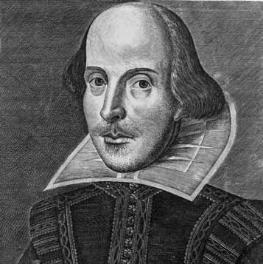
(Figure 1 – Droeshout engraving)
The following is an examination of a number of likenesses of Shakespeare, some well-known, some less so. The common features of these images are identified: those distinguishing marks which help us to recognise genuine portraits of the Bard. As I reveal the distinguishing features of Shakespeare portraiture, two other items will enter the equation. Both have interesting stories attached to them, and both may help us to make sense of the essential details we find in representations of Shakespeare’s face.
Let us first note some of the peculiarities of the Droeshout engraving. The head is quite clearly too big for the body. The forehead seems bulbous, almost hydrocephalic. The whiskers of the moustache and goatee are not very convincing. And there’s something strange about the left eye: a bump or bulge around the outer edge of the eyebrow. This, we shall discover, is one of the tell-tale signs of Shakespeare portraiture.
The Janssen bust
At about the same time as Martin Droeshout was engraving his image of Shakespeare, Gheerart Janssen was sculpting a bust to form part of the Shakespeare funerary monument in Holy Trinity Church, Stratford-upon-Avon. Gheerart Janssen was based in Southwark, but he had previously carved an effigy of Shakespeare’s friend, John Combe, which is also in the chancel of Holy Trinity Church.
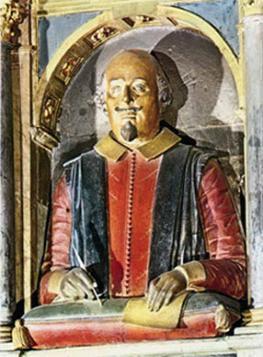
(Figure 2 – Janssen bust. © John Cheal, Inspired Images, 2012)
Janssen’s limestone bust of Shakespeare was completed by the time the First Folio of Shakespeare’s works was published in December 1623. But there’s something rather odd about its history. It was ‘re-beautified’ in 1649, and although we can’t be too sure what was meant by ‘re-beautified’ there are indications that it involved more than just a lick of paint. A sketch of the monument had been made by the antiquarian Sir William Dugdale in 1636.
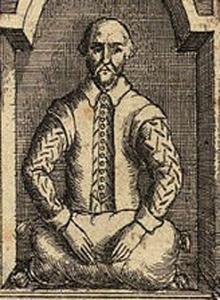
(Figure 3 – Hollar engraving, from Dugdale sketch)
Dugdale’s sketch was reproduced as an engraving by Wenceslaus Hollar in 1656, and there are marked dissimilarities between Hollar’s engraving, based on Dugdale’s sketch of twenty years earlier, and the bust as it now appears. In 1911 it was noted that the head of the bust was loose, resting precariously on the shoulders (Hammerschmidt-Hummel 2006: 126), and so it may be that the re-beautification of the Janssen bust entailed a major change – the creation of a new head to replace the original which had presumably been damaged by Puritan soldiers during the English Civil War. Sir William Dugdale’s sketch of 1636 would therefore depict the original head of the bust, before it was ‘re-beautified’ in 1649.
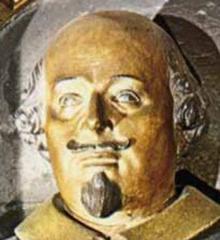
(Figure 4 – Janssen bust detail)
The bust as it exists reveals some interesting features. The moustache might have changed significantly since Dugdale made his pre-Civil War sketch of the monument, but there are no grounds for assuming that this is anything other than Shakespeare’s face. The forehead is the giveaway. Note the raised line ascending from the left temple and the distinct dent or depression near the top of the frontal bone. These are features we encounter again and again in images of Shakespeare, and nowhere are they more apparent than on the so-called Davenant Bust at the Garrick Club – so apparent, in fact, that someone in the past would appear to have tried to scratch them out of existence.
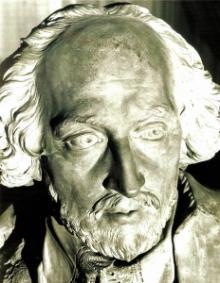
(Figure 5 – Davenant bust)
The Chandos portrait
The Chandos portrait was the very first item acquired by the National Portrait Gallery in 1856. The portrait is named after one of its owners: James Brydges, Duke of Chandos. Five years before James Brydges died in 1789, the Shakespeare scholar Edmond Malone noted on a copy of the portrait that the original had ‘formerly belonged to Sir William Davenant’. Sir William Davenant, whose name is also associated with the Davenant bust of Shakespeare, was remembered – in Oxford, at least – as Shakespeare’s godson. There were many jokes made about his relationship with Shakespeare, reflecting the gossip that Davenant was, in fact, Shakespeare’s natural son. Davenant himself encouraged that impression, and there are grounds for believing that it might have been true; Davenant certainly exhibited a lifelong attachment to Shakespeare and his memory. So we can take it that, if the Chandos portrait and the Davenant bust were both associated with Sir William Davenant, they were probably pretty good likenesses of his godfather.
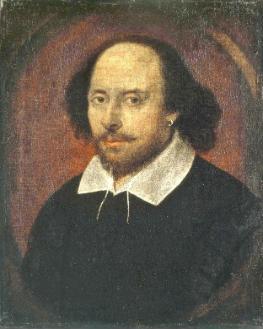
(Figure 6 – Chandos portrait)
Like the Droeshout engraving, the Chandos portrait shows a noticeable defect around the outer edge of the left eyebrow. There is also clear evidence of lines rippling across the forehead and a depression or two near the top of the frontal bone. One thing about the Chandos portrait has, to the best of my knowledge, never been picked up on. Millions of people have seen the portrait, but how many have noticed the strange grey line that can be seen running down the left cheek from just below the eye to the corner of the mouth?
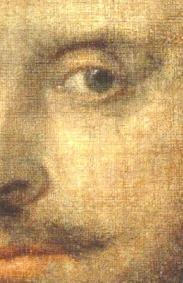
(Figure 7 – Chandos portrait detail)
That really is unusual – and, I believe, it can be explained.
The Cobbe portrait
However, let us first consider the Cobbe portrait.
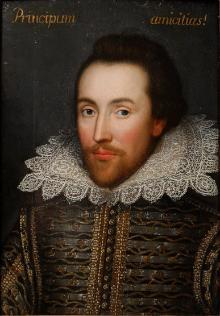
(Figure 8 – Cobbe portrait)
This was identified as recently as 2009 as being of Shakespeare.[1] There is also a portrait of Shakespeare’s patron, the Earl of Southampton, at Hatchlands Park in Surrey, where the Cobbe portrait is on display. The Cobbe portrait suggests that Shakespeare had a wall-eye. The left eye is set at a different angle from the right, and the eyebrow above the left eye appears to be slightly drooping or swollen.[2] We can also make out depressions in the forehead, and a faint line running down the left cheek.
The inscription – Principum amicitias! – is taken from an Ode written by the Roman poet Horace [3] to a friend who was also a poet, playwright, literary critic and historian. ‘You’re handling the Civil Wars,’ wrote Horace to his friend,
… the causes, mistakes, and methods,
Fortune’s game, and the dangerous friendships
Of princes [‘Principum amicitias’], and the unatoned-for
Blood on various weapons:
A task that’s filled with dangerous pitfalls,
So that you are walking over embers
That smoulder under treacherous ashes.
Horace continued: ‘soon, when you’ve finished covering / Public events, reveal your great gifts / Again in Athenian tragedy, / You famous defendant of troubled clients …’ The inscription on the Cobbe portrait therefore carries a hint of menace, encapsulating, as it does, a warning from one poet to another that some things are best left unwritten about.
The face in the Cobbe portrait is that of a youngish man, but that, I think, is deceptive. By way of comparison, we might consider the Flower portrait, which was donated to the Royal Shakespeare Company in the 19th century and was long thought to have been the original from which Martin Droeshout made his engraving for the First Folio.
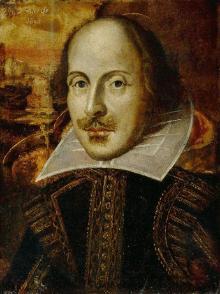
(Figure 9 – Flower portrait)
It was painted over a pre-existing image of the Virgin Mary with the Christ child and St John the Baptist and inscribed with the date 1609 – seven years before Shakespeare died. However, the pigment used for the gold braid of the doublet was not available before the early 1800s.[4] The Flower portrait is not as old as it pretends to be.
The Coblitz portrait
This portrait of Shakespeare claims to show us what the Bard looked like at the age of 34.
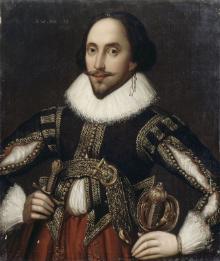
(Figure 10 – Coblitz portrait)
It was painted by Louis Coblitz, a French genre painter who spent much of his career in Germany and died, aged 59, at Mannheim in 1863.[5] Obviously, then, this portrait does not show us Shakespeare at the age of 34; it is an artist’s impression of the 34-year old Shakespeare. That said, the Coblitz portrait does hint at the lazy left eye, the distorted left eyebrow, the depression at the top of the forehead and the raised line running up from the left temple.
The Coblitz portrait gets us to the very crux of the problem of Shakespeare portraiture. The portrait is dated to 1847, so it was painted 230 years after Shakespeare died. The reference to the subject’s age in the portrait is purely notional. But the distinguishing details are there: the lazy eye, the drooping eyelid, the lines and depressions of the forehead are faithfully reproduced.
And there’s the rub. If there had been an authentic portrait of William Shakespeare, painted during his lifetime, from which subsequent artists drew their inspiration, we might expect a little more consistency in the images. The specific details might have been omitted – an artist might have preferred not to render the left eye as wonky or to recreate the bumps on the forehead – but the overall impression, the ‘look’ of each portrait, would be fairly similar. What we find, though, is the opposite. The distinctive details are consistent - the defects or abnormalities repeatedly appear where they should - but the ‘look’ of these portraits differs quite markedly. Put the Chandos and the Cobbe portraits together and they do not look like the same person, although the details are much the same and the proportions match.[6]
This does not suggest to me that the various representations all drew on an original portrait. If they had, the ‘look’ would be similar, even though some of the distinguishing details might have been lost.
A ‘Male Image in Plaster’
The Coblitz portrait of 1847 offers a clue as to what formed the model for most, if not all, of these Shakespeare images. Louis Coblitz was associated with the city of Mannheim in Germany. Five years before he painted his portrait of Shakespeare, a collection of art and antiquities was auctioned off. The collection had belonged to Count Franz Ludwig von Kesselstatt, Canon of Mainz Cathedral, who died in 1841, and among the items that were sold after his death was a small deathbed portrait bearing the date ‘1637’ and an inscription, ‘Shakespeare, nach der Tradition’ – ‘Shakespeare, according to tradition’. The deathbed portrait was almost certainly of Ben Jonson, who died in 1637, rather than Shakespeare, who died in 1616, but the discovery of this miniature led Dr Ludwig Becker, a court artist who had been based at the ducal palace in Darmstadt, to hunt down another item, a ‘plaster head’ or ‘male image in plaster’, which had also formed part of the Count von Kesselstatt’s collection (Hammerschmidt-Hummel 2006: 100-108). Dr Becker came across the deathbed portrait in 1847 – the same year as Louis Coblitz supposedly painted his portrait of Shakespeare ‘aged 34’. Two years later, in a junk shop in Mainz, Dr Becker finally tracked down the ‘plaster head’ he had been searching for. It was a death mask.
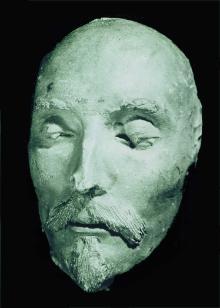
(Figure 11 – Darmstadt death mask. By permission of Universitäts und Landesbibliothek, Darmstadt)
The death mask found by Dr Ludwig Becker in Germany had been inscribed on the rear edge, while the plaster was still soft, with a small cross – denoting death – and the date, ‘Anno Domini 1616’, the year of Shakespeare’s death. Becker entrusted the death mask to the British Museum, where it was carefully studied by Professor Richard Owen, Superintendent of the Natural History department, whose father-in-law had recently taken possession of the Davenant bust when the Duke’s Playhouse in Lincoln’s Inn Field was pulled down. Richard Owen was convinced that the death mask Becker had found in Germany was the model used by Gheerart Janssen when he created the Shakespeare bust for the funerary monument in Holy Trinity Church, Stratford-upon-Avon.
We might find it more than a little coincidental that the plaster of Paris death mask, dated 1616, was discovered by Dr Ludwig Becker two years after Louis Coblitz painted his portrait of Shakespeare. Coblitz was based just a few miles from Darmstadt, where the Count von Kesselstatt had his collection until 1842, and from Mainz, where the death mask was recovered in 1849. I suspect that Louis Coblitz was one of the last artists to use the death mask as the model for a portrait of Shakespeare.
The death mask
The death mask certainly has some interesting features. It was made at least 24 hours after the death of the subject, as we can tell from the natural decomposition of the conjunctiva which has gummed the eyelashes together.
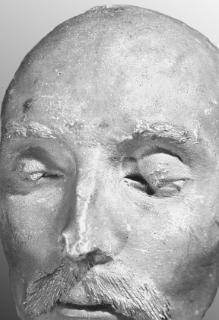
(Figure 12 – death mask detail)
The facial tissues have had time to relax, and this shows up the damage to the skull beneath the skin. This can be seen at the outer edge of the left eyebrow and in a thin line which runs down the left cheek. It is also possible to make out the depressions in the forehead which match those we’ve seen in the portraits of Shakespeare. The left eyeball is forced forwards in its socket, which might explain the wall-eye of the portraits.
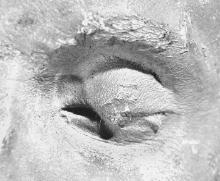
(Figure 13 – death mask, left eye detail)
There is also a very noticeable thin grey line or scar on the death mask, running from the bridge of the nose to the left eyelid. If we look closely at the portraits we tend to find a thin blue line in this position, or some hint of darkening suggesting damage to the inner corner of the left eye socket.
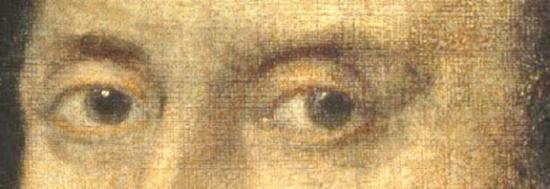
(Figure 14 – Chandos portrait detail)
The death mask might solve the mystery of why so many Shakespeare portraits preserve the same distinguishing features – depressions in the forehead, damage to the left eye socket, etc. – while, at the same time, presenting rather different ideas of what Shakespeare actually looked like. In each instance, a ‘living’ face had to be reconstructed from the death mask. The Droeshout engraving (Fig. 1) even gives the impression of having been modelled on a mask, the edge of which we can see as a hard outline running down the side of the face. It is not too difficult to imagine a mock-up being created by resting the mask against a wooden block, which was then ‘dressed’ with an appropriate-looking wig. The fact that the earlobe in so many of the Shakespeare portraits is so unconvincing also argues in favour of the death mask being the model: there are no ears on the death mask.
So a portrait artist, commissioned to create a posthumous visual representation of Shakespeare, might have had recourse to the death mask from which the details of Shakespeare’s face could be drawn. A degree of artistic licence was required to translate the dead face into a living image, and so various attempts were made to imagine what that face would have looked like before Shakespeare died. The trick was to take this monochrome model of a dead man’s face and convert it into an image of the living Shakespeare at some earlier stage in his life.
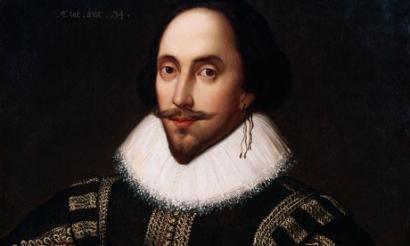
(Figure 15 – Coblitz portrait detail)
Each artist approached the problem in his own way, and thus the portraits are all slightly different, although the specific details remain essentially the same.[7]
‘A Warwickshire Man’
We still need to account for those distinguishing facial features, some of which appear to be pathological or traumatic in nature. The discovery of the death mask in the mid-19th century was naturally exciting, and not just for artists; scientists were fascinated by it, too. Was there any way of proving beyond all reasonable doubt that the death mask was Shakespeare’s? Potentially, yes. If his grave in Holy Trinity Church were opened, and his skull exhumed, it could be compared with the death mask. Shakespeare’s gravestone in the chancel of Holy Trinity does not mention his name or any personal information. Rather, it reads:
Good friend, for Jesus’ sake forebear
To dig the dust enclosèd here:
Blest be the man that spares these stones,
And cursed be he that moves my bones.
The scientific community might have wanted to open up Shakespeare’s grave, but superstition and the gravestone ‘curse’ presented an obstacle to their plans.
As the debate was raging, an article was published by a clergyman based in Kent. It appeared in the Argosy magazine in October 1879, its author identifying himself as ‘A Warwickshire Man’. His proper name was the Reverend Charles Jones, although he changed his surname, just as his article appeared, to Langston.[8] He told a remarkable – and remarkably detailed – story, which he entitled, How Shakespeare’s Skull was Stolen. A trainee surgeon from the town of Alcester, a few miles from Stratford, was inspired to break into Shakespeare’s grave one night in December 1794. Dr Frank Chambers, as he was known in Langston’s account, took Shakespeare’s skull with the intention of selling it to Horace Walpole.[9]
Five years later, in 1884, Rev. Charles Jones Langston published the rest of his story. He had moved by then to the vicarage at Beoley, a small village on the Worcestershire-Warwickshire border, close to Alcester, where Langston himself was born. And although he did not name the village or indicate that he was now the vicar of that parish, he gave another highly detailed account of how he had discovered the ‘VERITABLE SKULL OF WILLIAM SHAKESPEARE’ in an ossuary underneath a private family chapel attached to the Church of St Leonard in Beoley.
‘Marred by a jagged hole’
When I read Langston’s revised account of How Shakespeare’s Skull was Stolen and Found, I was struck by two things. First, where the skull was found. It was nestling in a funerary urn which had held the viscera of Ralph Sheldon, who died in 1613. Ralph Sheldon was related to Shakespeare by marriage; there was in fact a whole web of connections that linked them. Sheldon was described as ‘as good a Catholic as any in England’ [10] by Cardinal William Allen, who founded English colleges for Catholics on the continent, and who might well have been William Shakespeare’s godfather.
Ralph Sheldon had built the chapel adjoining the chancel of Beoley church in order that his family might have a Catholic place of worship on what were Church of England premises. The altar table in the chapel was reputedly presented to Ralph Sheldon in person by Pope Gregory XIII, and so the chapel is probably unique: very few Anglican places of worship still boast an altar that was blessed by the Bishop of Rome. The skull, then, was allegedly found in the most Catholic place imaginable: in the crypt of a Catholic family, and in the funerary urn associated with the most defiantly Catholic member of that family, who also happened to be related to William Shakespeare.[11]
As Langston described it in his published accounts, the forehead of the skull, when he found it, was ‘marred by a jagged hole’ (A Warwickshire Man 1884: 46). I wondered whether this ‘jagged hole’ might match the ‘scar or indentation’ running across the forehead of the death mask, above the right eyebrow (Norris 1884: 3).
The Beoley skull
I spent several weeks trawling through census records and trade directories to establish how many of the individuals named in Rev. Charles Jones Langston’s account of How Shakespeare’s Skull was Stolen and Found had actually existed in the area at the time. By and large, they had. The many incidental details in Langston’s story proved to be accurate, even though I have to admit that the story as a whole did not ring true.
Then came a stroke of luck. The crypt beneath the Sheldon Chapel at Beoley Church is opened up once every five years for an architect’s inspection. The last time it was opened up, in September 2009, a local journalist, Richard Peach, managed to get in there with his camera.[12] There is a spare skull in the ossuary underneath the Sheldon Chapel, almost exactly as Langston described it in 1884 (minus the ‘jagged hole’ in the forehead; the ‘jagged hole’ is actually at the base of the skull, raising questions as to why Langston wanted to draw attention to the forehead).
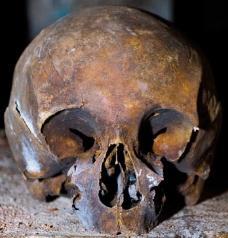
(Figure 16 – Beoley skull, © Richard Peach, Platform Media, 2009)
Langston, the vicar of Beoley who published his account of How Shakespeare’s Skull was Stolen and Found, indicated that the alleged theft of the skull from Stratford had been initiated by Horace Walpole. Walpole was intimate for many years with Lady Browne, who was in fact a member of the Sheldon family, born at Beoley.[13] There is a depression in the forehead of the skull, near the top of the frontal bone. Indeed, there are several depressions grouped around the coronal suture, which also appear in the portraits. My own sense is that these depressions were lifelong distinguishing features: one can almost imagine the midwife gripping the head with her left hand a little too forcefully as she pulled the baby from his mother’s womb.[14]
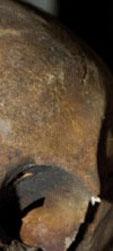
(Figure 17 – skull: indentations, left temple)
Those fingermarks apparently impressed themselves in the soft bone of the cranium, and when the bones hardened and the plates fused, the coronal suture did not form smoothly, which is why we see a raised coronal suture and accompanying depressions in the skull in the busts, portraits and the death mask of Shakespeare.
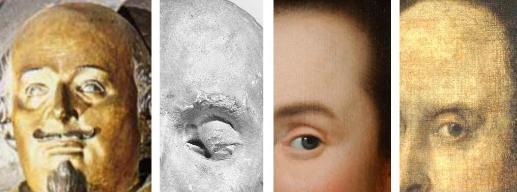
(Figure 18 – comparison of forehead indentations: Janssen, death mask, Cobbe, Chandos)
The surface of the skull is a little bumpier over the left eyebrow than it is over the right. An expert of my acquaintance assures me that this happens where there is an absence of fatty tissue. We all have these fatty deposits in our eyebrows, and the fact that it appears to be missing from half of the left eyebrow would indicate the presence of scar tissue. This may be why Shakespeare’s left eyebrow is often portrayed as drooping or swollen – there was a deep scar on or immediately above his left eyebrow, and it had been there for many years before he died.
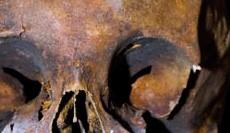
(Figure 19 – skull detail)
At the outer edge of the left eyebrow, the skull is broken. The fracture at the outside corner of the left eye matches the tiny bone fractures visible through the relaxed facial tissue of the death mask and appears in the portraiture, either as thin lines – replicating the death mask – or a distinct swelling. If the eye sockets were damaged shortly before death, then the prominent jagged burr at the edge of the left eyebrow would have caused just such a swelling as we see in the Chandos portrait (Fig. 6) and the engraving by Martin Droeshout (Fig. 1).
The mandible (lower jaw) of the skull is missing, as are the teeth. The maxilla (upper jaw) is broken on both sides. The outline of the broken maxilla on the left side of the face is reproduced as a jagged grey line running down the cheek of the Chandos portrait (Fig. 7); it can also be made out in the Davenant bust, the Droeshout engraving, the Cobbe portrait and the death mask.
A piercing instrument
There is also damage to the inside of the eye socket. This can be seen more clearly on an older photograph of the skull, taken in about 1939 (Fig. 20). It would appear that some sort of sharp pointed instrument was driven into the left eye socket, piercing small holes in the medial wall. In doing so, this pointed instrument forced the left eyeball forwards in its socket – as we see in the death mask and the lazy eyes of the portraits. It also created the thin grey scar that is plainly visible on the death mask, between the bridge of the nose and the eyeball (Fig. 13). The instrument penetrated the skin of the inside corner of the eye and punctured two holes in the thin wall of the eye socket.
Christopher Marlowe was killed in exactly the same way.[15]
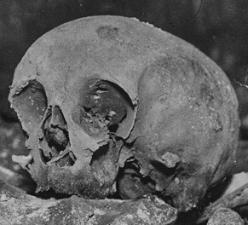
(Figure 20 – Beoley skull, circa 1939, with visible damage to interior of left eye socket)
The same sharp pointed instrument, incidentally, would probably have made the two deep scratches running up the right side of the skull. What kind of sharp pointed instrument would have made these scratches? Ben Jonson might have provided a clue. Jonson was never very good at keeping a secret. He had already referred to 'the Graver' having 'hit [Shakespeare's] face in his short poem commending the Droeshout engraving[16], and in his longer prefatory poem for the First Folio he wrote:
… Shakespeare’s mind and manners brightly shines
In his well-turnèd and true-filèd lines,
In each of which he seems to shake a lance,
As brandished at the eyes of ignorance.[17]
‘Shake a lance’ is so obviously a pun on Shakespeare’s name that we might overlook what Ben Jonson let slip: the ‘lance’ was ‘brandished at the eyes’. A popular weapon of the day was the poignard or poniard. It was stabbing weapon – blunt-edged, often three-sided, with a sharp point. Ben Jonson seems to have carried one, a dagger ‘with a white haft’ which he ‘ordinarily wore at his girdle’.[18]
The Wadlow portrait
There is a portrait that I have kept till last, because it is very special. It was brought to my attention by the owner, who had already established that it was painted on a wooden panel in the early years of the 17th century. We’ll call it the Wadlow portrait.
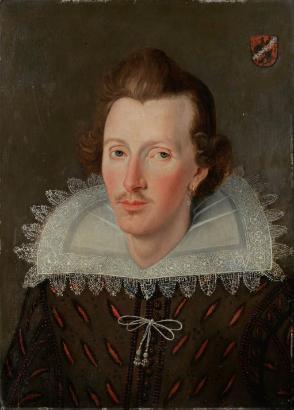
(Figure 21 – Wadlow portrait. Photo and permission by Chris Titmus, Hamilton Kerr Institute)
It’s Shakespeare’s face. It matches the proportions of the Chandos portrait (Fig. 22), the Cobbe portrait, and others. It has the wall-eye, the swollen or drooping eyebrow, the signature depressions in the forehead. It even shows the prominent scar above the left eyebrow which possibly caused the eyebrow to droop (Fig. 23). The presence of that scar meant that there was an absence of fatty tissue and a consequent effect on the skull, the surface of which duly became ‘bumpier’ in the immediate region of the scar.
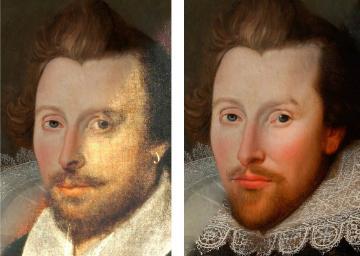
(Figure 22 – comparisons of Wadlow with Chandos and Cobbe portraits)
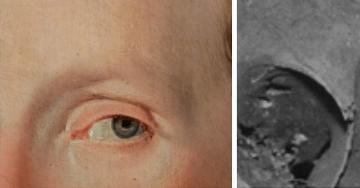
(Figure 23 – comparison of scar on left eyebrow, Wadlow portrait and Beoley skull)
The Wadlow portrait (Fig. 21) has been altered in times past, especially around the right eye (x-ray and infra-red photographs reveal that the outer edge of the right eye originally followed the lines of the Droeshout, Chandos, and other portraits). The coat of arms is entirely made up, probably to replace an authentic coat of arms. But notwithstanding the alterations, the purpose of which seem to have been to conceal the identity of the subject, it is Shakespeare, and one of the most intriguing and lifelike portraits that I’ve seen of the Bard.
We don’t know who commissioned it, but I imagine it was a Catholic. In fact, I suspect that most of our Shakespeare portraits were Catholic keepsakes. They commemorate a martyr, a man who was killed because he was an eloquent and persuasive mouthpiece for the Catholic cause [19]; we remember the words of Horace – ‘You famous defendant of troubled clients’ – which are hinted at in the inscription on the Cobbe portrait. If we look more closely at the doublet in the Wadlow portrait we see little groupings of five points arranged in the form of a quincunx and representing, perhaps, the Five Wounds of Christ, which was a Catholic symbol of resistance to the Protestant policies of Elizabeth and James I.
The doublet is ‘pinked’ to show the expensive scarlet lining. The impression is one of slash marks and flesh wounds. In the middle, poking through the doublet, is a neat bow. Jenny Tiramani, an expert in period costume, has admitted that she has never seen the band strings of a shirt collar poking through a buttonhole like this. The detail of the bow in the Wadlow portrait is extremely unusual. More than anything, it appears to resemble a dragonfly.

(Figure 24 – Wadlow bow detail and dragonfly comparison)
The symbolism of the dragonfly
The dragonfly had rather sinister connotations. The insect’s long, thin body and huge eyes, which account for some 80% of its head, suggested a sharp pointed weapon. And so in England the dragonfly was popularly known as the Devil’s darning needle.
Colloquial names for the dragonfly from various parts of Europe reflected its elongated body shape. It was known in France and Germany by names meaning ‘knife-like’, and in Italy, Germany and Sweden as ‘needle-like’, a ‘shooting needle’, ‘little pin’ or ‘arrow’. The French also called it Aiguille du diable, the ‘Devil’s needle’, or Agent du diable, the ‘Devil’s agent’. The Germans called it Teufelsnadel, ‘Devil’s needle’, or Teufelsbolz, the ‘Devil’s bolt’. In Finnish, it was the ‘Devil’s servant’; in Italian, Guida or ‘Judas’. In German, French, Norwegian and Portuguese, the dragonfly was widely known as ‘Eye-sticker’, in Italian ‘to cut the face’, and in French, Pisse-en-z’yeux, ‘to squirt poison into the eye’ (Mitchell and Lasswell 2005: 209-212).
Another word for a needle, and particularly a darning needle, was ‘bodkin’.[20] The same word appears in Hamlet’s soliloquy: ‘For who would bear the whips and scorns of time … When he himself might his quietus make / With a bare bodkin?’.[21] A long needle was also a bodkin, which was also a poniard, a needle-like stabbing weapon, and so there was a clear association of ideas: needle = bodkin = poniard = dragonfly. The shape of the dragonfly suggested a darning needle, a bodkin or a poniard, and its disproportionately large eyes inspired such colloquial names as ‘Eye-sticker’.
The dragonfly bow seen poking through the pinked doublet, with its blood-red slash marks, is as clear an indication as we could hope for that the cause of Shakespeare’s death was no real secret. It was known in certain circles, and it was something that wealthy Catholics sought to commemorate. The evidence suggests that he was stabbed through the eye socket with a poniard which, like a dragonfly, shot ‘poison’ into his eye and ‘cut his face’. That evidence can be found in the ‘VERITABLE SKULL OF WILLIAM SHAKESPEARE’ in the Sheldon vault beneath Beoley church, in the plaster of Paris death mask now in Germany, and in the many and various posthumous portraits of our greatest writer, who was almost certainly silenced – or ‘stopped’, as Ben Jonson put it [22] – because of his outspoken Catholic beliefs.
Bibliography
BBC News, ‘Shakespeare portrait ‘is a fake’’, BBC News Channel (22 April 2005) <http://news.bbc.co.uk/1/hi/entertainment/arts/4471515.stm> [Accessed 13 March 2014]
Brown, Mark, ‘A New View: is this the real Shakespeare?’, Guardian (10 March 2009) <http://www.theguardian.com/culture/2009/mar/10/shakespeare-cobbe-portrait> [Accessed 12 March 2014]
Donaldson, Ian, Ben Jonson: A Life (Oxford: Oxford University Press, 2011)
Edmond, Mary, Rare Sir William Davenant: Poet Laureate, Playwright, Civil War General, Restoration Theatre Manager (Manchester: Manchester University Press, 1987)
Hammerschmidt-Hummel, Hildegard, The True Face of William Shakespeare: The Poet’s Death Mask and Likenesses from Three Periods of His Life, trans. Alan Bruce (London: Chaucer Press, 2006)
Jones Langston, Rev. C. – ‘A Warwickshire Man’, How Shakespeare’s Skull was Stolen and Found (London: Elliot Stock, 1884)
Mitchell, Forest L. and Lasswell, James L., A Dazzle of Dragonflies (College Station, Texas: Texas A&M University Press, 2005)
Nicholl, Charles, The Reckoning: The Murder of Christopher Marlowe (London: Picador, 1993)
Norris, J. Parker, The Death Mask of Shakespeare (Philadelphia: Franklin Printing House, 1884)
Peach, Richard, ‘Is this Shakespeare’s Skull?’ The Village, 95 (October 2009)
Picard, Liza, Restoration London: Everyday Life in London 1660-1670 (London: Phoenix, 2005)
Richardson, Ralph, Saint Leonard’s Church Beoley, Worcs. A brief history and guide for visitors (Beoley: St Leonard’s Church, 2002)
Schoenbaum, Samuel, Shakespeare’s Lives (New York: Barnes & Noble, 2006)
Stirling, Simon, Who Killed William Shakespeare? The Murderer, The Motive, The Means (Stroud: The History Press, 2013)
Wells, Stanley and Taylor, Gary, eds., William Shakespeare: The Complete Works, 2nd edn (Oxford, Oxford University Press, 2005)
Notes
[1] Mark Brown, ‘A New View: is this the real Shakespeare?’, Guardian (10 March 2009) <http://www.theguardian.com/culture/2009/mar/10/shakespeare-cobbe-portrait> [Accessed 12 March 2014].
[2] Professor Stanley Wells, Honorary President of the Shakespeare Birthplace Trust, who identified Shakespeare as the subject of the Cobbe portrait, argued that the portrait was the original from which the Janssen portrait, now in the Folger Shakespeare Library, Washington D.C., was copied. The Janssen portrait (http://en.wikipedia.org/wiki/File:Janssen_portrait.jpg) has features in common with the Cobbe and other Shakespeare portraiture, including the swollen or drooping left eyebrow and depressions in the forehead.
[3] Horace Odes 2:1, addressed to Asinius Pollio.
[4] BBC News, ‘Shakespeare portrait ‘is a fake’’, BBC News Channel (22 April 2005) <http://news.bbc.co.uk/1/hi/entertainment/arts/4471515.stm> [Accessed 13 March 2014].
[5] Coblitz’s death was entered in the Chronicle of the City of Mannheim for 19 April 1863. His portrait of Shakespeare is now in the Musée National du Château de Versailles et du Trianon. I am grateful to Lee Durkee for pointing out to me the similarities between the Coblitz portrait and the Hampton Court portrait of Shakespeare in The Royal Collection.
[6] The Soest portrait (http://en.wikipedia.org/wiki/File:Soest_portrait_of_Shakespeare.jpg), which is said to be of Shakespeare, is also worthy of consideration as it appears to display many of the distinguishing features discussed herein.
[7] The death mask was returned to Germany after Dr Ludwig Becker’s death in 1861. The mask was put up for auction in 1960 and bought by the director of the Hessen State and University Library; it is now in the Universitäts - und Landesbibliothek in Darmstadt Castle.
[8] The Times, 26 September 1879.
[9] Horace Walpole, 4th Earl of Orford (1717-1797), was the fourth son of Sir Robert Walpole. A prominent antiquarian, art historian and Gothic novelist, he was descended from a family of Catholic recusants and martyrs. Walpole was also related to Francis Seymour-Conway, 2nd Marquess of Hertford. According to Langston’s account of How Shakespeare’s Skull was Stolen and Found, it was at Ragley Hall, Lord Hertford’s Palladian mansion near Alcester, that Dr Frank Chambers was inspired to steal Shakespeare’s skull: Walpole had apparently offered 300 guineas to anyone who could bring him the skull of William Shakespeare.
[10] Ralph Richardson, Saint Leonard’s Church Beoley, Worcs. A brief history and guide for visitors (Beoley: St Leonard’s Church, 2002), p. 34.
[11] For details of some of the relationship strands linking Ralph Sheldon and William Shakespeare, and the possibility that Dr (later Cardinal) William Allen was Shakespeare’s godfather, see Simon Stirling, Who Killed William Shakespeare? The Murderer, The Motive, The Means (Stroud: The History Press, 2013), p. 95 and pp. 273-6.
[12] Richard Peach, ‘Is this Shakespeare’s Skull?’, The Village, 95 (October 2009).
[13] Frances Sheldon (died 1790) was the daughter of Edward Sheldon and Elizabeth Shelley. She married Sir George Browne (died 1754). Lady Browne was Walpole’s neighbour for many years in Twickenham; he playfully referred to her as his ‘wife’. Her ancestral background was steeped in Catholic recusancy, and she was related, via both her mother and her husband, to the family of Shakespeare’s patron, the Earl of Southampton.
[14] Midwives in the early modern period tended to be in a hurry and would frequently cut the amniotic sac with a sharpened coin or fingernail and then wrench the baby from the mother’s womb; see Liza Picard, Restoration London: Everyday Life in London 1660-1670 (London: Phoenix, 2005), p. 94.
[15] Charles Nicholl, The Reckoning: The Murder of Christopher Marlowe (London: Picador, 1993), p. 18.
[16] ‘…O, could he but have drawn his wit / As well in brass, as he hath hit / His face …’ Ben Jonson, ‘To the Reader’, 5-7.
[17] ‘To the memory of my beloved, The AUTHOR MASTER WILLIAM SHAKESPEARE, AND what he hath left us’, 67-70.
[18] Ian Donaldson, Ben Jonson: A Life (Oxford: Oxford University Press, 2011), p. 402.
[19] The Puritan historian John Speed wrote, in his Theatre of the Empire of Great Britaine (1611) of the Jesuit Robert Persons, then rector of the English college in Rome, and William Shakespeare as ‘this Papist and his Poet, of like conscience for lies, the one ever feigning, and the other ever falsifying the truth’. Later in the 17th century the Anglican clergyman Richard Davies, chaplain of Corpus Christi College, Oxford, noted that Shakespeare ‘died a Papist’.
[20] Experimenting on himself, Sir Isaac Newton (1642-1727) once forced a darning needle around the side of his eye so that he could poke at the rear of his own eyeball and reported seeing ‘white, darke & coloured circles’ so long as he kept stirring with ‘ye bodkin’.
[21] Hamlet 3.1.72, 77, 78.
[22] Ben Jonson, ‘De Shakespeare Nostrati’ in Timber, or Discoveries Made Upon Men and Matter (1641). Quoted from Samuel Schoenbaum, Shakespeare’s Lives (New York: Barnes & Noble, 2006), p. 28.